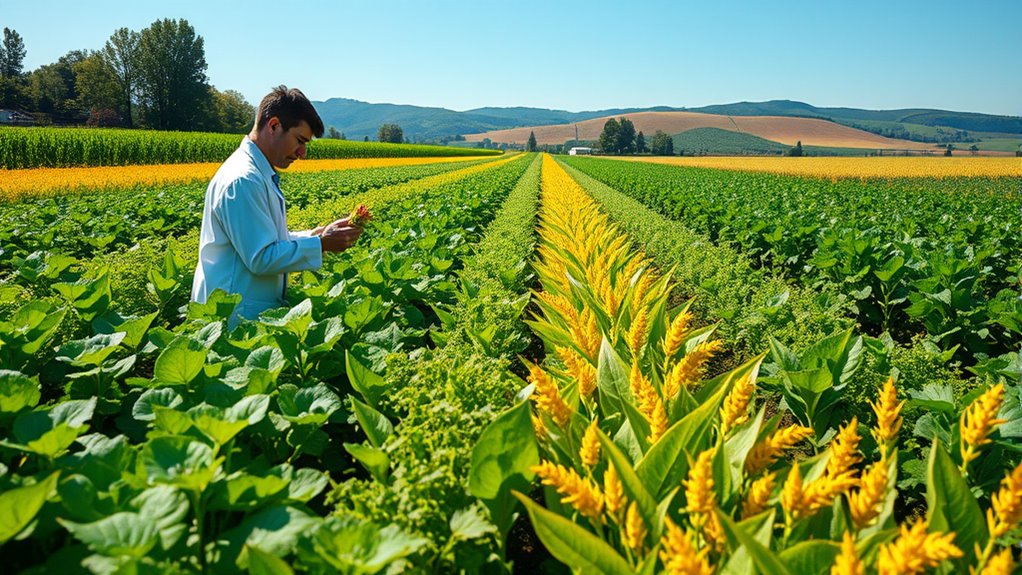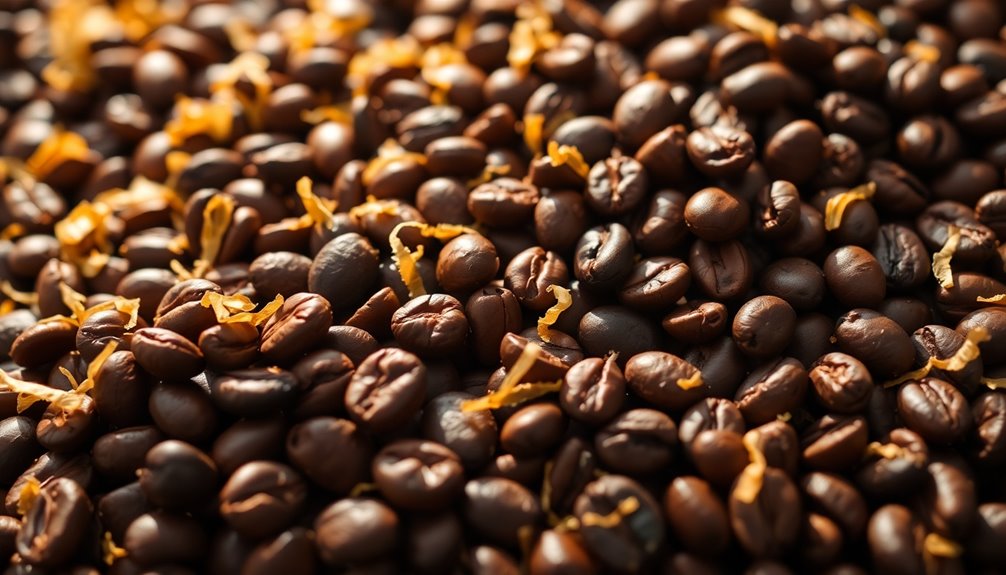To develop climate-resilient varieties, focus on harnessing genetic diversity and drought-tolerance traits within crops. F1 hybrids, created by crossing genetically distinct parents, often display hybrid vigor, boosting yields and resilience under stress. Combining these hybrids with advanced breeding tools like marker-assisted selection and genetic modification accelerates the development of adaptable, stress-resistant crops. If you explore further, you’ll discover how these innovations are shaping the future of resilient agriculture.
Key Takeaways
- F1 hybrids combine genetically diverse parent lines to enhance traits like drought tolerance and stress resistance.
- Hybrid vigor in F1 hybrids results in higher yields and improved resilience under climate stressors.
- Advanced breeding tools, such as marker-assisted selection and genetic modification, accelerate development of climate-resilient F1 hybrids.
- Utilizing genetic diversity allows breeders to incorporate multiple stress-tolerance traits into F1 hybrids.
- Integrating new breeding techniques ensures rapid creation of adaptable, climate-resilient crop varieties for changing environments.

As climate change accelerates, developing crop varieties that can withstand extreme weather conditions becomes more urgent. The increasing frequency of droughts, heatwaves, and unpredictable rainfall patterns threaten global food security. To tackle these challenges, scientists are focusing on harnessing genetic diversity within crop species. By exploring a wide range of genetic traits, breeders can identify and incorporate genes that confer resilience to stressors like drought, ensuring plants can survive and produce even under adverse conditions. This approach is essential because genetic diversity provides the raw material needed for developing climate-resilient varieties, enabling crops to adapt to changing environments more effectively.
Harnessing genetic diversity is vital for developing climate-resilient crops.
In particular, drought tolerance has become a key trait in breeding programs. You’ll find that drought-tolerant varieties can maintain stable yields during periods of water scarcity, reducing the risk of crop failure. Breeders work on selecting plants that naturally possess traits such as deep root systems, efficient water use, and the ability to close stomata quickly to conserve moisture. These traits are often found within the genetic diversity of the crop species, and by leveraging advanced breeding techniques, scientists can enhance these characteristics in new varieties. This process involves crossing plants with desirable traits and selecting offspring that exhibit improved drought tolerance, a method that accelerates the development of more resilient crops.
The introduction of F1 hybrids plays a fundamental role in this effort. F1 hybrids are produced by crossing two genetically distinct parent lines, often resulting in offspring with hybrid vigor or heterosis. This means the hybrid plants tend to outperform their parents in growth, yield, and stress resistance. When designed carefully, F1 hybrids can combine multiple traits like drought tolerance and disease resistance, providing a more robust solution for farmers facing climate stressors. You benefit from such advancements because these hybrids often offer higher yields and better resilience without requiring additional inputs, making them economically attractive for farmers in vulnerable regions.
New breeding techniques, such as marker-assisted selection and genetic modification, further enhance the development of climate-resilient varieties. These tools allow scientists to pinpoint specific genes associated with drought tolerance and other stress adaptations, speeding up the breeding process. As a result, you’re more likely to access crop varieties that are better equipped to withstand the unpredictable impacts of climate change. Overall, by focusing on genetic diversity, harnessing drought tolerance traits, and utilizing innovative breeding strategies, researchers are paving the way for crops that can thrive despite the mounting challenges posed by a changing climate.
Frequently Asked Questions
How Do F1 Hybrids Compare to Traditional Varieties in Yield?
F1 hybrids generally outperform traditional varieties in yield because they’re bred for ideal genetic traits, leading to better growth and productivity. However, they often have lower seed purity and less genetic diversity, which can make them vulnerable to pests and diseases over time. You might find that hybrids offer higher initial yields, but relying solely on them could reduce long-term resilience, so balancing with traditional varieties can be beneficial.
What Are the Main Challenges in Developing Climate-Resilient Varieties?
You’ll face challenges like maintaining genetic diversity, which is crucial for resilience, as breeding focuses on specific traits. Ensuring these varieties meet farmers’ needs encourages adoption, but farmers may hesitate to switch from traditional crops. Additionally, developing climate-resilient varieties requires significant resources and time, and balancing high yield with robustness against climate stresses can be complex. Overcoming these hurdles is essential for successful, widespread implementation.
Can F1 Hybrids Adapt to Changing Climate Conditions Over Time?
You might think F1 hybrids can easily adapt to changing climates, but ironically, their genetic stability is often short-lived, limiting long-term adaptation. While they excel initially, their ability to evolve with shifting conditions is questionable. Over time, without further breeding, they may struggle to keep pace, making you wonder if relying on them truly offers a lasting climate-resilient solution. Adaptation requires more than just a good start.
What Is the Cost Difference Between Developing New Hybrids and Traditional Varieties?
Developing new hybrids often costs more upfront than traditional varieties because of higher research funding needs and complex regulatory hurdles. You’ll face expenses for advanced testing, safety assessments, and approvals. While traditional varieties require less investment initially, the long-term benefits of climate-resilient hybrids may justify the higher costs, especially as they adapt better to changing conditions. Investing wisely now can lead to more sustainable yields later on.
How Do Farmers Access and Select the Best Climate-Resilient Hybrids?
Think of selecting hybrids as finding a needle in a haystack, but your experience guides you. You access climate-resilient hybrids through seed selection, often relying on local seed companies, agricultural extension services, or farmer networks. Farmer participation is vital—by sharing insights and trialing different varieties, you help identify the best hybrids for your climate. This hands-on approach guarantees you choose resilient seeds that can withstand changing weather patterns.
Conclusion
By choosing climate-resilient F1 hybrids and new breeding techniques, you can substantially boost crop yields and adapt to changing weather patterns. Did you know that some resilient varieties can produce up to 30% more harvests under stress conditions? Embracing these innovations not only secures your food supply but also helps protect the environment. Stay ahead by investing in these advanced varieties—they’re your best chance to thrive in a changing climate.










